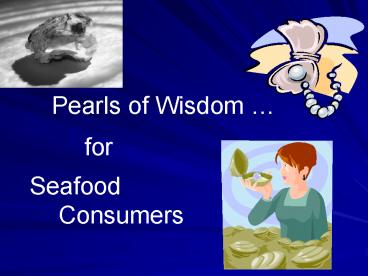Pearls of Wisdom PowerPoint PPT Presentation
1 / 19
Title: Pearls of Wisdom
1
Pearls of Wisdom for
Seafood Consumers
2
Seafood is Good for Health
- High in protein
- Most species low in calories fat
- Low in saturated (bad) fat
- Contains omega-3 fatty acids which
- Decrease inflammation (as in arthritis)
- Reduce risk of strokes heart attacks
- May reduce risk of Alzheimers disease
- Lower incidence of cancer aid treatment
- American Heart Assoc. recommends 2 or more
servings of seafood per week
3
Additional Attributes
- Easy to chew and digest
- for consumers who have dentures, few teeth, or
swallowing problems (elderly, toddlers) - Easy to prepare cooks quickly
- Available in single or multiple servings
- Variety - many species of fish shellfish
- Available fresh, frozen, canned
4
Bivalve Molluscan Shellfish
- Have two shells hinged together
- Cannot swim or move around
- Filter nutrients from surrounding water
- Examples oysters, clams, mussels
- Nutritional benefits
- 5 grams or less of fat in 3-ounce cooked serving
- Contain omega-3 fatty acids
- Good source of iron, zinc, iodine, magnesium,
selenium, and other trace minerals
5
Bivalves are Unique
- Entire animal is eaten, including stomach
intestines - Usually consumed raw or lightly cooked
- Except scallops
- Usually cooked
- Only abductor muscle is eaten
6
Most foods from animals (beef, poultry, eggs,
fish, pork) are cooked prior to consumption.
However, oysters, clams, mussels are often
consumed raw or partially cooked. Illnesses
sometimes occur from eating raw bivalves, and
although most are typically not life threatening,
incidences of serious illness and death have been
reported.
Eating raw bivalves can increase risk of illness
cooking can reduce the risk of illness.
7
Ensuring Safety
Because bivalves may be eaten raw, extra
precautions are taken by federal, state, local
agencies to ensure safety.
- Bivalve meats growing waters are tested for
microbial chemical contamination. - Waters are either approved or closed to
harvesting according to test results. - Seafood dealers that handle, process, or sell raw
bivalves are licensed, certified, inspected.
8
Role of Consumers
- Obtain oysters, clams, or mussels from stores or
people with valid business licenses. - Do not take shellfish from areas that are closed
or not approved for harvesting. - Do not eat bivalves that die prior to cooking
- or shucking.
- If you have health conditions that make
- you susceptible to infection, eat cooked
- bivalves, and avoid eating them raw.
9
Vibrio vulnificus Bacteria
( Vib're-o vul-nif'?-kus )
- Naturally present in seawater shellfish,
especially in bivalves during warm weather - Not a result of pollution or contamination
- May cause illness in some consumers (average
of 95 U.S. cases/year) - Rarely infects healthy
- people
- Thorough cooking
- kills bacteria
10
Health Conditionsthat increase risk of Vibrio
vulnificus infection
- Liver disease
- Diabetes
- Cancer
- AIDS / HIV
- Iron overload disease
- Stomach disorders
- Alcoholism
- Chronic kidney disease or failure
- Weakened immune system
If you are unsure of your risk, consult your
doctor.
11
Modes of Vibrio vulnificus Infection
- Seafood (50 cases)
- Eating raw or undercooked seafood, especially
oysters - Wounds (50 cases)
- Exposing pre-existing wound or sore to seawater
or raw seafood - Swimming, wading, fishing, handling raw seafood
- Obtaining wound from marine-related activity
12
Vibrio vulnificus Infection in High-Risk
Consumers
- Symptoms often occur within 3 to 48 hours
- Illness quickly becomes severe
- Requires immediate medical treatment
- Death may occur in as few as 1 or 2 days
- Average food case fatality rate is 50
- 61 in alcoholic consumers
- 60 in consumers with
- liver disease
13
Symptoms of Vibrio vulnificus Infection may
include
- Fever / chills
- Stomach pain/ nausea/ vomiting
- Diarrhea
- Red skin lesions - may develop into blisters,
sometimes filled with blood - Shock (sharp drop in blood pressure)
- Swelling, pain, redness, blisters, /or dead
tissue around wound
14
Preventing Infection is Easy
High-risk consumers (those with one or more
health conditions) should take the following
precautions to avoid Vibrio vulnificus infection
- Do not expose wounds or sores
- to seawater or raw seafood
- Avoid eating raw or undercooked seafood,
especially oysters - Eat thoroughly cooked bivalves
15
Cooking Guidelines
U.S. Food Drug Administration recommendations
for shucked bivalves
for live bivalves
- Discard dead bivalves
- Use small pots dont overload
- Boil for 3 to 5 minutes after shells open
- Steam for 4 to 9 minutes in pot with boiling water
- Boil or simmer for 3 minutes
- Broil 3 inches from heat for 3 minutes
- Deep fry at 375F for at least 3 minutes
- Bake 10 minutes at 450F
- Increase times for large quantities or recipes
with additional ingredients
16
Industry Efforts to Improve Safety
The Gulf oyster industry is currently using
three federally approved processes that reduce
Vibrio vulnificus bacteria to non-detectable
levels in oysters after they are harvested. In
addition, they are researching other effective
post-harvest processes. Although these
processes effectively kill Vibrio bacteria, they
have not been validated to remove all other
harmful bacteria or viruses. Thus, it is not
recommended that high-risk consumers eat raw
post-harvest processed oysters.
17
Summary
- Seafood is nutritious
- heart healthy
- Do not stop eating seafood,
- but make safe choices based
- on your health conditions
- Consumers at high risk for infection should eat
thoroughly cooked bivalves and avoid raw or
undercooked seafood (also meat, fish, poultry,
eggs)
18
For more information, including recipes, please
visit the web site SafeOysters.org which has
consumer and fishermen information in English,
Spanish, Vietnamese.
19
This slide show was developed by Tori Stivers,
BSA, MS Seafood Specialist University of Georgia
Marine Extension Service with funding from
National Sea Grant

